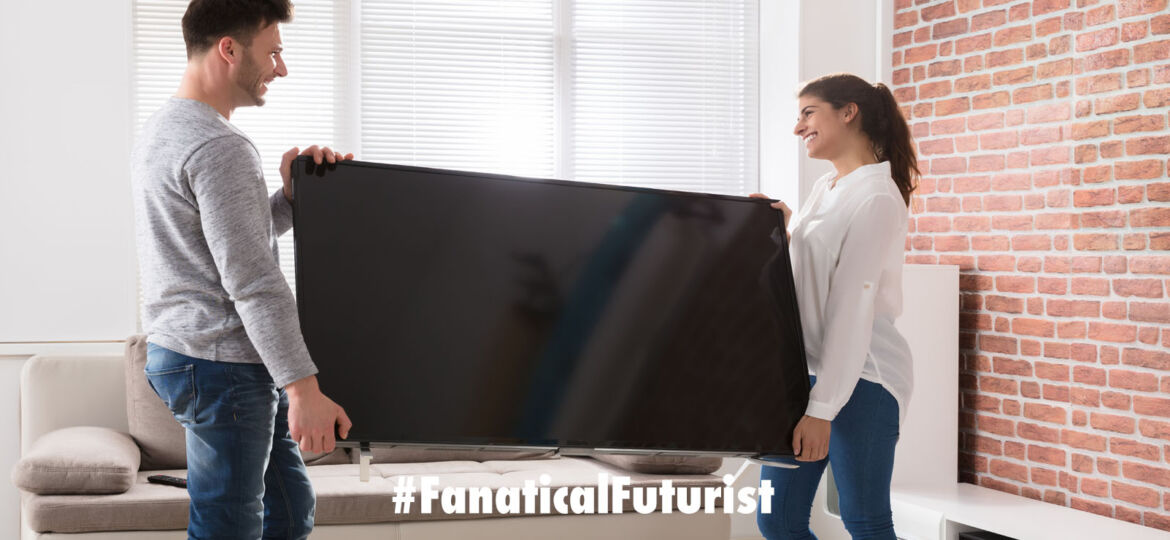
WHY THIS MATTERS IN BRIEF
Cables of all kinds are a hassle, and this is the world’s first TV that powers itself wirelessly.
 Love the Exponential Future? Join our XPotential Community, future proof yourself with courses from XPotential University, connect, watch a keynote, or browse my blog.
Love the Exponential Future? Join our XPotential Community, future proof yourself with courses from XPotential University, connect, watch a keynote, or browse my blog.
A lot has been happening in the world of future TV’s recently – there’s the unveiling of the world’s first 16K screen, the world’s first vertical, and the world’s first sideways rollable TV’s, and, of course, the world’s first transparent TV, and a TV with a brain. But as futuristic as all these TV’s are they still have one ancient thing in common – they all have a power cable.
Usually when we talk about “cutting the cord” it means disconnecting the cable or satellite feed from the TV and streaming content over Wi-Fi. But Russian startup Reasonance has bigger plans for TV cord cutting. The wireless TV prototype it just showed at CES 2021 leaves the electrical cord behind in favour of a wireless power transmission and reception system.
See the new TV for yourself
TVs have been getting thinner and lighter for decades, able to stand or mount virtually anywhere. But those pesky wires are still holding them back. They look unsightly when dangling down from the a wall-mounted screen and create issues when attempting to place the TV too far from an electrical outlet.
Could wireless transmission be the answer? Not yet, but Reasonance is working on it. The company’s wireless TV loses the power plug and gains a standalone electrical transmitter and a receiver coil integrated into the TV. The company explains that its “reasonance” technology differs from other magnetic resonance tech in developing a magnetic field by both conduction and displacement currents. It says that efficiency rises up to 90 percent, at a cost affordable enough to use in consumer electronics.
Reasonance’s system can send power over distances up to a meter (3.3 ft) and can continue to operate efficiently even if the transmitter and receiver coils are not perfectly aligned. The company says the transmission distance could be increased by adjusting the size of the coils – as they were when the US Department of Energy developed a new powerful wireless charging system for electric vans.
The CES prototype has an external receiver coil on the back of a 40-in TV. The company says the coil could also be integrated into the TV frame itself, though the current coil would bloat the sleek flat-panel construction. The transmitter coil is set on a table just below, off-centered and perpendicular in relation to the TV, and Reasonance says that it could also be placed inside a wall or a piece of furniture without interfering with operation. The system transmits 120 watts of power at a frequency of 20 to 120 kHz over a distance of 20 in, or 50 cm.
Reasonance isn’t the first to research the idea of wireless TV. In fact, Samsung, the world’s largest television manufacturer, had originally planned to bring its own wireless TV to last year’s CES but ultimately decided the tech wasn’t ready. Jong-Hee Han, Samsung’s president of Visual Display, cited poor efficiency among other issues as the reason it left the TV back at the lab, South Korea’s Yonhap News Agency reported at the time.
Reasonance believes its tech solves efficiency and cost issues to the point that it could be integrated into marketable products. It has patented the tech in Russia and applied for patents in the US, EU, China, India, Canada and South Korea. It intends to license its technology to existing manufacturers, as opposed to building its own products, citing a wide range of alternative potential applications that go beyond TVs, to include appliances and electric bikes at home, to electric vehicles and smart roads.
















